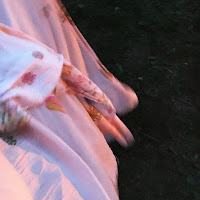During the evening of Litha, June 21st, the sun was so strong - the light seemed to never fade away. I spent my time outside amongst nature, side-by-side to a burning bright fire slowly watching the darkness bloom. During certain Sabbats, spending time watching flames is very comforting to me and can be very meditating. The ancient technique of fire gazing can produce surprising results during ritual. Images may appear in the flames that may be symbolic. Here is an interesting article on the benefits of candle gazing - how it opens the third eye and helps with focus and concentration.
Billowing gray smoke was thick at the bottom of the pit, before a sudden burst of flame dissolved the smoke. Flames danced about, and I began taking photos. Since roaring flames are rapid and every changing so quickly, having a camera can help you see symbols and shapes at a later time. During my hour or so amongst the flames and taking time to burn incense and eat a few s'mores, I took around a hundred photos – below are some of those photos that I found to be symbolic:
THE GODDESS:
The first image shows the flowing goddess with her arm raised, with flowing bell sleeve, holding something in her hand. The second is who I think is symbolic for Gaia, the ancestral mother of all life, in organic form with her arm forming a branch with a single leaf.
The Goddess
THE GOD:
The Great one, Pan, the Horned God is my male deity, who showed up unexpectedly in my life a few years ago. Then back in February, during the burning of Yule pines, I also captured him in the flames. The two, I captured on Litha are almost identical images but reversed, and both have a masculine structured chiseled chin.
Goddess & God fire images from burning of the Yule Pines
The Horned God or Batman?
The Horned God
LITHA ALTAR:
Specifically for Litha, I tailored my altar to the Egyptian sun god, and the ankh, the symbol of life. To pay my respects, I offered up sweet honey as a gift to the gods. Honey was a powerful nectar in ancient Egypt, it was used it as a sweetener, a gift to the gods and was medicinal, also as an ingredient in embalming fluid. While excavating Egyptian pyramid, archeologists found honey pots dating back approximately 3,000 years.
NEFERTITI:
The Egyptian Queen Nefertiti, meaning “the beautiful one has come”, looks as if she is standing in the smoke as a silhouette with her headdress called the Modius, which was originally adorned with encircled cobras as protection from her enemies. She is a goddess of sexuality, fertility and rebirth. During the reign of her and the Pharaoh Akhenaten they introduced the concept of Monotheism which was the worship of the sun god, Aten.
THE PHOENIX:
The Phoenix, Bennu in Egyptian, has long been associated with the worship of the sun for it’s symbolism of resurrection and the rising sun. The Bennu bird represented the soul of Ra, the bringer of light and god of the sun. During my fire gazing, I was mystified to see the Phoenix, as the sacred Bennu bird destroys itself in the flames and rises from the ashes after building a nest of power to rise from the ashes. The first image looks as if there is a large Phoenix head, slightly off center to the left, with its beak pointed down. The second resembles the Phoenix rising with its wings spread.
ANIMAL SYMBOLS:
The Rabbit:
The rabbit ears peaking from out of the flames made me smile, as they are one of my favorite creatures. They can symbolize abundance and comfort, but also fertility, and have long been associated with the Goddess, as a totem of Artemis and Hecate, and the sacred rabbit of Aphrodite. Other meanings include the moon, love, success, agility and creativity. They have long been associated with magic and the ability to cross between worlds and the Fae.
The Robin:
The Robin throughout history is associated with charity, compassion, good and bad luck, life and death. The red breast of the Robin has a strong association with fire and said to have brought fire from heaven. In Norse mythology, the Robin was a bird of storm held high by Thor.
The Stag:
The Stag with antlers is associated with fertility of the God, and is a symbol of all wild creatures, especially those give themselves away to serve the life of the people. Seeing the stag, also represents to me Herne the Hunter, the god of the Wild Hunt, who is a nature god who appears as a stag or bull and is sacrificed each year to symbolize life, death and rebirth. I found this most special as I've been fascinated lately with Herne and recently purchased a figure of Herne in Jim Thorpe, PA.
After my evening by the fire and reviewing my photos I was astonished by the beautiful fire symbols, especially those related to the sun. What do you see in these photos?
References:
National Geographic. (2015, November 23). Honey in the Pyramids. Retrieved from




























